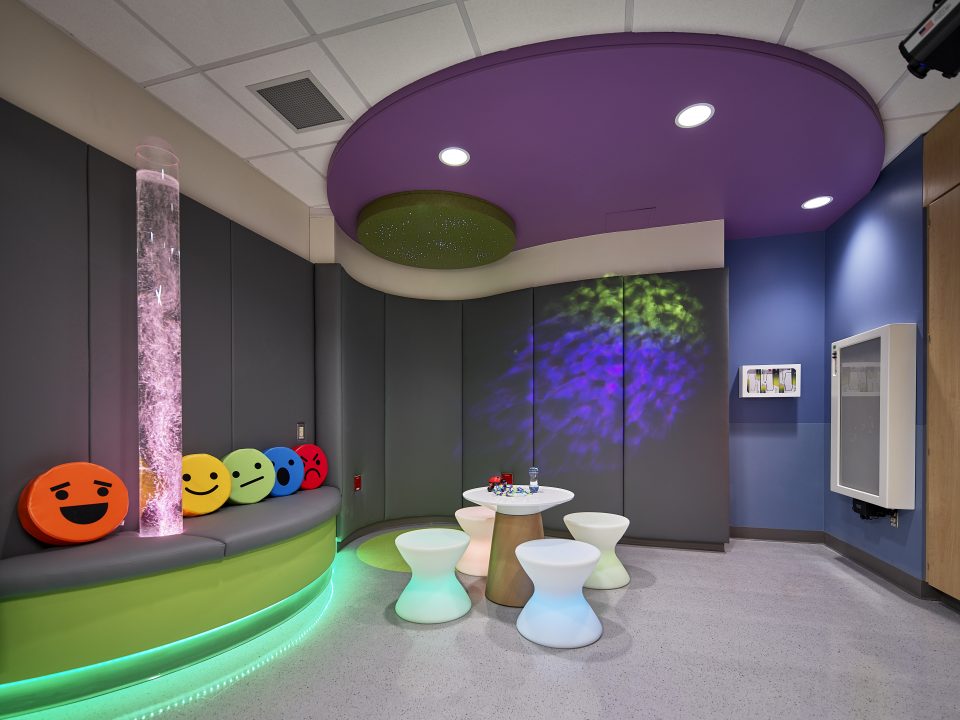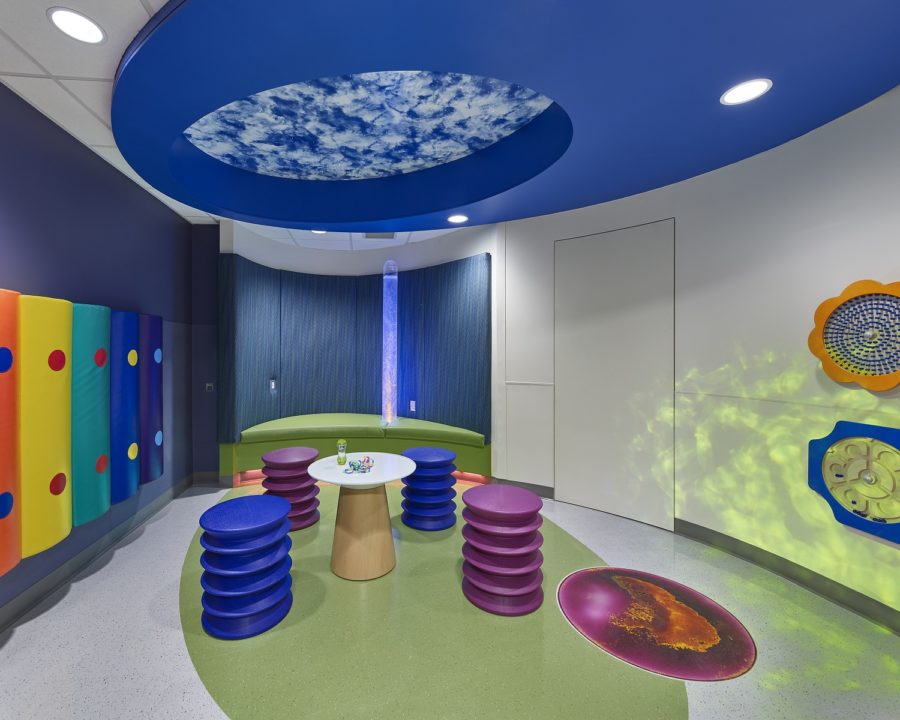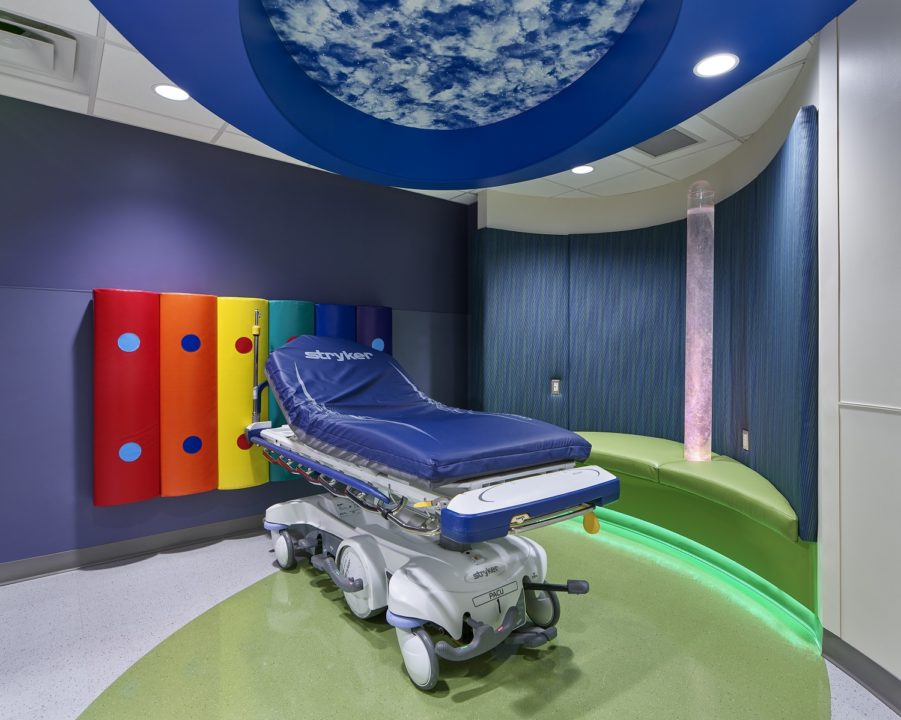The sensory rooms at Robert Wood Johnson University Hospital, New Brunswick were recently featured on the front page of the Asbury Park Press, highlighting the positive impact that the spaces have had on the hospital and its patients. DCC designer Laura Hill worked closely with the project team to create a safe, comfortable, and functional environment that would be aesthetically pleasing and interesting while meeting hospital standards for infection control. The sensory-friendly rooms are located within the Emergency Department and were a part of a larger master plan expansion and renovation that has completed its final phase.
Learn more about this groundbreaking project here, and view the full article below.
*Photography by Jeffrey Totaro, not featured in the published article.
Autism-friendly emergency room: Robert Wood Johnson’s charming space comforts patients
Kelly-Jane Cotter, Asbury Park Press Published 5:00 a.m. ET Jan. 23, 2020 | Updated 7:48 a.m. ET Jan. 23, 2020
Nobody likes to go to the emergency room.
But if you have autism or sensory issues, the experience can be even less pleasant. The crowded space, the beeping of medical equipment, gurneys whizzing down the halls. The sights, sounds and smells associated with people who are suffering and frightened. Imagine having autism and facing all of that at once, while dealing with your own health crisis. It can be incapacitating.
Luckily, hospitals throughout the nation are increasingly aware of the needs of patients with autism, providing training to staff and comfort items to patients, such as noise-canceling headphones, weighted blankets, fidget toys and iPads, which allow some patients to communicate more easily.
Robert Wood Johnson University Hospital in New Brunswick has taken that autism-friendly approach even further. The hospital’s newly expanded emergency department now includes two separate rooms — one for children, one for adults — that look nothing like a traditional hospital room.
The hospital opened its adult room at the end of 2019. The pediatric room opened in December 2018. Each has been used daily ever since. Sometimes, even patients who do not have autism benefit from the rooms.

“A young child could be intimidated by a blood drawing,” said Barbara Romito, head of the Child Life program at Bristol-Meyers Squibb Children’s Hospital at RWJUH. “It offers a nice distraction.”
The addition of these emergency rooms came as part of a two-year expansion of the emergency department.
Beauty and whimsy are not qualities you’d expect to find in a hospital, let alone in an emergency department. Yet here they are, in the form of curving benches and sweet-faced emoji pillows. Adjustable lighting can temper or accentuate the saturated colors of the walls and decor.
The room for adults could be mistaken for a lounge, with its chunky, space-age furniture and mood lighting.
Designer Laura Hill, of DCC Design Group in Wilmington, Delaware, created a landscape, of sorts, for the adult room. On the ceiling, there is a cloudy sky with twinkling stars. On a back wall, a pattern that evokes a gentle rainfall. The floor has a grass-green area. And a key feature is a set of colorful, pressurized bars on the wall that resembles a rainbow. If you press or lean against the squishy bars, they make a small, vibrating sound that can be comforting to those on the spectrum.

The autism-friendly rooms are in the corner, so they are already partly removed from the hustle and bustle, and every aspect of their design helps to enhance a feeling of privacy and calm.
The rooms close with tinted sliding doors, rather than curtains. Medical equipment is stowed behind closet doors and cabinets. A child-size table and small chairs are in the center of the pediatric room. There is space for a hospital bed, but a bed is not wheeled in unless needed. A broken arm, for example, could be treated without putting a patient in a bed.
“We aimed for flexibility, a customizable room,” said Dina Karmazin Elkins, chair of the RWJUH Foundation and herself the mother of a 17-year-old son, Hunter, with autism. “My son is usually with me and his teacher, or me and his nanny, so we wanted to make sure there would be room for several family members.”
Because people do not outgrow the characteristics of autism, the needs of adults on the spectrum are not much different from the needs of kids with autism. So the features of the pediatric and adult rooms are similar.
Small canisters of Play-Doh and bottles of bubbles also are in cabinets, designed for single use. Sterility is key in an emergency room, so care was taken to stock supplies in individual sizes.
“We had to think about what are the comfort items we can provide while still keeping everything safe and sterile,” Romito said. “Bean bag chairs and baskets, for example, can’t be cleaned.”
In designing these emergency rooms, Hill had to balance her aesthetic vision for the space with the safety requirements of a hospital.
“It is less institutional, but everything had to be bleach-cleanable,” Hill said. “So there are no crevices.”
But there is still plenty of texture and tactile appeal. The walls in both rooms are padded, so that patients don’t injure themselves. The emoji pillows, which are used to help patients communicate their feelings or level of pain, much as a Likert scale is used throughout hospitals, are made of a smooth material that is easily cleaned.

What’s more, patients can stay in these rooms throughout their visit, while waiting to be seen and for treatment. That way, patients do not have to travel to another room and re-adjust.
“It couldn’t just be a waiting room,” Karmazin Elkins said. “That was a big deal.”
Karmazin Elkins counts herself lucky because she has never had to take Hunter to an emergency room. But she is glad that he could be seen in such an environment if the need arose.
“Future families can visit, to get kids used to it,” she said.
Other hospitals have made strides toward helping patients with autism. For example, the emergency department of Community Medical Center in Toms River provides training for staff and comfort items and sensory tools for patients.
In 2016, Capital Health Medical Center in Hopewell opened two autism-friendly rooms in the pediatric area of the emergency department, with amenities such as softer lighting, sensory toys on the walls and sound barrier curtains.
Dr. Anjali Sharma-Moghe, chair of the department of pediatrics, and Stephanie Singer, nurse manager of the pediatric emergency department, say that the rooms have been beneficial to Capital Health’s growing number of patients with autism.
“In 2019, we had 371 patients who had a diagnosis of autism,” Singer said.
“And that was up from 298 autistic patients in 2017,” Dr. Sharma-Moghe added.
Karmazin Elkins expects that more hospitals will follow these examples.
“There’s a growing awareness about autism,” she said. “You’ll start to see more of this and you’ll see families advocating for it.”
Kelly-Jane Cotter enjoys writing about the needs and lifestyles of families. Reach her at kcotter@gannettnj.com, follow her@KellyJaneCotterand read more of her features here.